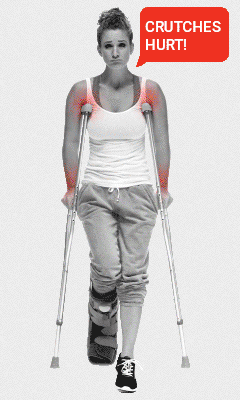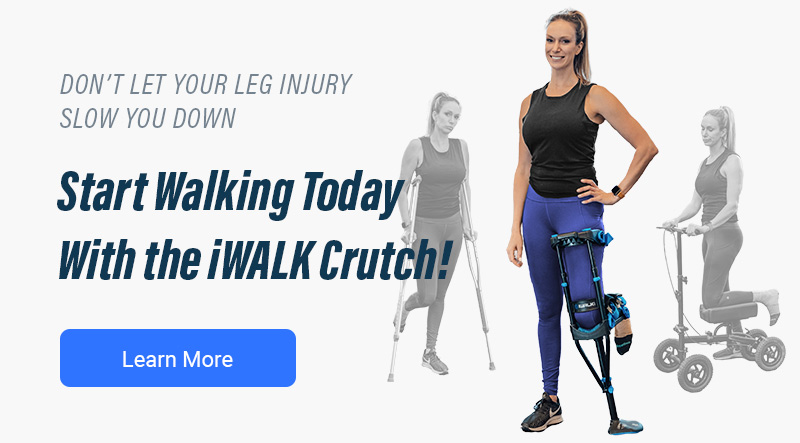Lower Leg Injury Resource Center
Broken Foot & Foot Fracture
Causes, Symptoms, Treatments & Recovery

A foot fracture, or broken foot, occurs when one or more foot bones break as a result of either a sudden trauma or chronic overuse. Regardless of the cause, a broken foot can be a serious injury with a lengthy recovery that may require that you keep weight off your injured foot. Proper knowledge about your particular foot fracture can help you make the most educated choices to ensure your recovery is as comfortable and efficient as possible.
I
HOW MANY BONES ARE IN YOUR FOOT?
The foot is a complicated part of the body that performs a variety of unique tasks. Its 26 bones work together to support all of your body’s weight, maintain balance and propel you through dynamic movements like running and jumping.
The foot is divided into three primary parts: the forefoot, midfoot and hindfoot.
The long front part of the foot is called the forefoot and is made of 19 bones including metatarsals and phalanges. The midfoot is comprised of five bones called the navicular, cuboid and cuneiforms. The hindfoot has only two bones: the calcaneus, which forms the heel, and the talus, which connects to the ankle.
I
PRIMARY TYPES OF FOOT FRACTURE
There are two overarching types of foot fractures: full foot fractures that are caused by sudden traumatic events and stress fractures caused by overuse. While the level of pain you may experience from either kind of foot injury may feel similar, there are crucial differences.
Stress fracture of the foot: A stress fracture of the foot is a break in one or more bones and is caused by repeated stress over time.
Full Foot Fracture: There are two types of full foot fractures, both typically the result of a one-time trauma like a car crash or dropping a heavy object on the foot. Full foot fractures can be either simple or compound.
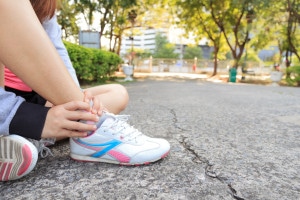
Simple fractures, also called closed fractures, do not damage surrounding skin or tissue. Compound fractures, also called open fractures, damage surrounding skin and tissue.
Generally speaking, open foot fractures are more serious than closed foot fractures because the break is usually severe enough to break through skin and tissue. An open fracture is also more susceptible to infection due to the open wound and damage to the soft tissue of the foot.
Specific Kinds of Foot Fractures
With 26 bones in your foot, there are a number of kinds of breaks. Several specific foot fractures include:
- Metatarsal fracture, a break of one of the long bones in your midfoot.
- Jones fracture, a break of the fifth metatarsal on the outside of your foot.
- Lisfranc fracture, a break in the complicated midfoot joint directly over your arch.
Foot Fractures in Athletes
Athletes often suffer from stress fractures that worsen over time because of a tendency to mistake them for strains or sprains. Stress fractures can be challenging for patients to diagnose because no single action caused the break. Overuse and repeated stress from activities like running or jumping are the most common causes of this kind of foot injury.
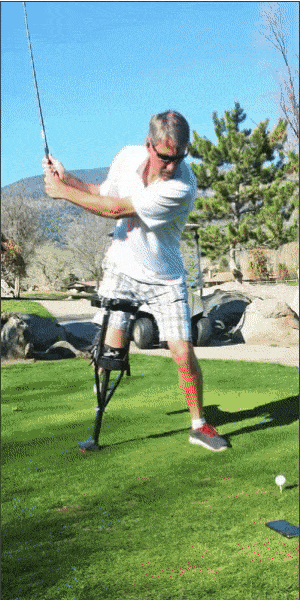
Three factors contribute to the likelihood of developing a stress fracture in your foot: impact frequency, impact duration and impact intensity.
All three factors relate to repeated impacts from activities like running or jumping. A hurdler, for example, would generate high intensity impacts to the foot. A long distance runner would generate a long duration of impacts. Both activities put athletes at some level of risk.
If you suspect you’ve suffered a full foot fracture or a stress fracture, promptly see a medical professional for an accurate diagnosis, treatment and rehabilitation plan.
I
WHAT ARE SYMPTOMS OF A BROKEN FOOT OR FOOT FRACTURE?
Foot fracture symptoms range from bruising to intense pain. Consult the following list and see a medical professional immediately if you have one or more of these common foot fracture symptoms:
Foot pain that increases when you stand on it,
Foot pain that steadily increases in severity over time,
Swelling along the top of the foot or outside of the ankle,
The ankle or foot is tender to the touch,
The ankle or foot shows signs of bruising in certain cases.
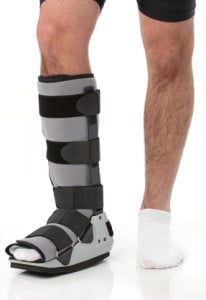
I
BROKEN FOOT & FOOT FRACTURE TREATMENTS
If you’re diagnosed with a stress fracture or traumatic foot fracture, your doctor will prescribe a treatment plan based on the severity and nature of your injury. There are non-surgical and surgical treatments.
Non-Surgical Treatment of a Foot Fracture
Surgery is not typically necessary for a foot fracture, but only your doctor will be able to fully assess if your type and severity of foot fracture can be successfully treated without surgery.
If no surgery is needed, your doctor may prescribe most or all of the following actions to facilitate recovery as safely and quickly as possible.
- Rest, Ice, Compression and Elevation: The benefits of implementing rest, ice, compression and elevation (RICE) are well established for a broken foot or foot fracture. By staying off the injured foot, icing it multiple times a day, wrapping the foot, and elevating it, you help reduce swelling and increase blood flow. This initial treatment accelerates the body’s natural healing process.
- Keeping weight off the injury: Your doctor will probably recommend that you don’t put weight on your broken foot for a lengthy period of time. Even limping on a broken foot can cause it to be reinjured and significantly slow recovery time. Crutches or a crutch alternative like the iWALK hands-free crutch are usually necessary for foot injuries.
- Casts and walking boots: Your doctor will probably prescribe some level of protection your foot while it heals. The most common are casts and walking boots. It’s common for doctors to require immobilization for six to 12 weeks, depending on the severity and complexity of your foot fracture.
Surgical Treatment of a Foot Fracture
Surgery is not always required to heal a broken foot, but it may be necessary if multiple bones are broken, if the breaks are severe, or if you have one of the more complicated forms of foot fracture such as a Jones fracture or Lisfranc fracture.
When surgery is needed to repair a broken foot, it often involves fasteners such as pins, screws or plates. Fasteners provide the necessary support for a bone or bones to heal with correct alignment, and that can lower the risk of re-injury.
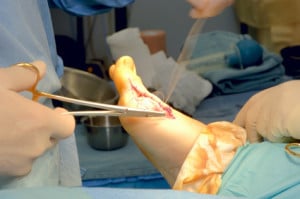
The path to recovery following surgery is generally the same as it is for those who have been prescribed a non-surgical treatment plan. More severe breaks and complicated surgeries will generally require longer periods of immobilization and recovery.
Regardless of your specific treatment, listening to and following your doctor’s instructions is a vital part of making your recovery go as smoothly and efficiently as possible.
I
RECOVERY & REHABILITATION FOR FOOT FRACTURES
Most people recovering from a foot fracture will have to keep weight off the injured foot for six to 12 weeks or longer, depending on the severity and specific type of injury.
A good mobility device can help you manage day-to-day activities during this time, and may even help accelerate recovery. Studies have shown that devices like the iWALK hands-free crutch can stimulate lower leg muscle engagement and improve blood flow while simultaneously immobilizing the foot. This could speed a lengthy recovery period.
A good mobility device is also important because it can help you avoid the temptation to cheat during your period of non-weight bearing activity. Even one or two steps could easily reinjure your foot and significantly increase recovery time. The best mobility device for your injury and lifestyle can make the difference between a successful and failed recovery.
I
MOBILITY DEVICES FOR A BROKEN FOOT & FOOT FRACTURES
Traditional Crutches
While crutches are inexpensive and common, they can cause pain in your hands, wrists, forearms and chest. What’s more, they make common everyday tasks impossible because they require exclusive use of your hands and arms. Due to these limitations, using traditional crutches often leads to cheating and increases the risk of re-injury.
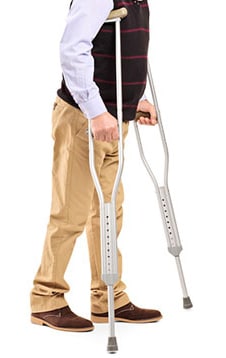
Knee Scooters or Knee Walkers
Knee scooters, sometimes called knee walkers, are increasingly popular because crutches are so challenging to use. With knee scooters, you kneel on a raised platform with your injured leg and roll by propelling yourself with your uninjured foot.
Knee scooters are efficient for distances on even terrain but do not work on grades, in tight places or on stairs. They are heavy, bulky and difficult to transport. They also require use of hands and severely limit routine activities. As with crutches, users of knee scooters may also be tempted to cheat and risk re-injury.
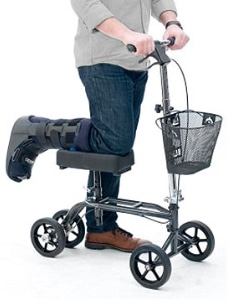
iWALK Hands-Free Crutch
The iWALK hands-free crutch is a pain-free, hands-free crutch alternative that combines the best of knee scooters and conventional crutches. You kneel on a platform like a knee scooter, but your weight is supported by your leg, not your hands and arms.
Unlike a knee scooter, the iWALK hands-free crutch is lightweight, inexpensive and 100 percent hands-free. It facilitates normal walking using the crutch as an extension of your leg. This means you can return to routine activities like walking the dog, taking out the trash and excercising.
Moreover, studies show the iWALK simulates normal walking in a way that engages upper and lower leg muscles while immobilizing the foot. This boosts blood flow in the lower leg and foot, which could speed recovery times. Because you’re engaging all of your leg muscles while using the iWalk you also avoid the muscle atrophy that happens when using traditional crutches or knee scooters.
The iWALK hands-free crutch is fast and easy to learn and use, and enables you to navigate stairs and tight spaces like a kitchen or bathroom. You can even use it while showering. Because the iWALK hands-free crutch allows you to return to your daily activities, it completely eliminates the temptation to cheat.
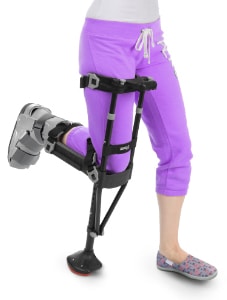
I
FOOT FRACTURE FINAL THOUGHTS
Dealing with a broken or fractured foot can be challenging, but if you’re an active participant in your recovery you will find ways to stay positive during the healing process. You’re going to be laid up for a while, and possibly be ordered not to stand or bear weight on your injured foot for a period of six to eight weeks. It’s important to find the best mobility device for you, so that you’re fully compliant with your doctor’s orders and can regain mobility and independence while taking care of your broken or fractured foot.
The information above is intended for informational purposes only and is not intended to prevent, treat, or diagnose any illness or disease. We aim to provide the highest quality information, so if you have any questions on the information above, we welcome your feedback!
I
RESOURCES
- Metatarsal Fracture (acute) – Aftercare. MedlinePlus Medical Encyclopedia. U.S National Library of Medicine. Web. 4 May 2021. http://www.nlm.nih.gov/medlineplus/ency/patientinstructions/000571.htm
- “Discovery Health.” Discovery Fit and Health. N.p., n.d. Web. 4 May 2021. http://health.howstuffworks.com/diseases-conditions/musculoskeletal/foot-injuries11.htm
- Nordqvist, Christian. Medical News Today. MediLexicon International, n.d. Web. 4 May 2021. http://www.medicalnewstoday.com/articles/173312.php
- Stress Fractures of the Foot and Ankle-OrthoInfo – AAOS. Stress Fractures of the Foot and Ankle. OrthoInfo – AAOS. N.p., n.d. Web. 4 May 2021. http://orthoinfo.aaos.org/topic.cfm?topic=a00379
- Foot Care Health Centre. Stress Fractures: Symptoms, Diagnosis and Treatment and How to Avoid Them. N.p., n.d. Web. 19 Feb. 2014. http://www.webmd.boots.com/foot-care/stress-fractures-symptoms-diagnosis-treatment
- Cuyler Dewar, MS, Kevin D. Martin, DO, FAAOS, DAL. Comparison of Lower Extremity EMG Muscle Testing With Hands-Free Single Crutch vs Standard Axillary Crutches. 2020 Sept 2. https://journals.sagepub.com/doi/full/10.1177/2473011420939875

